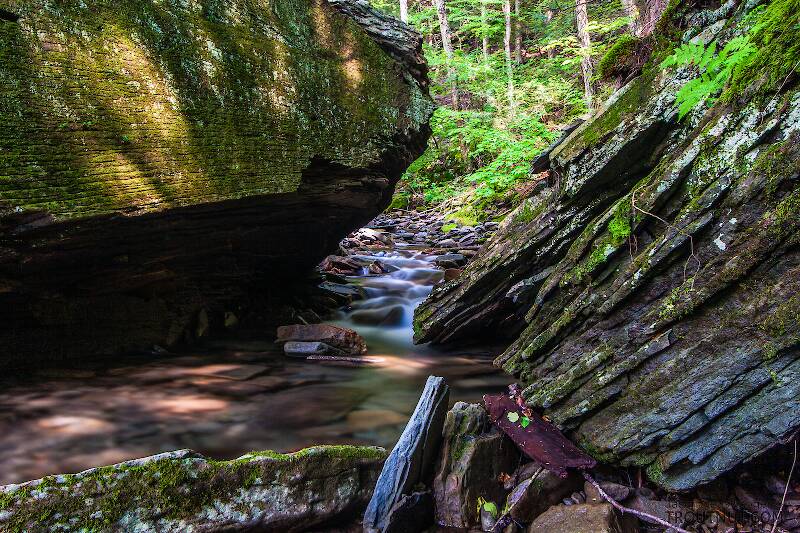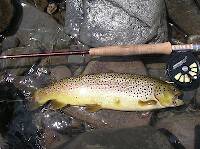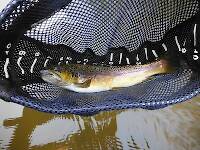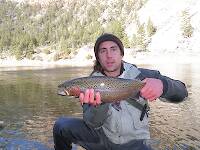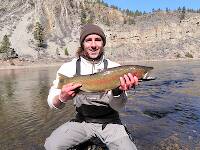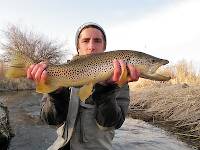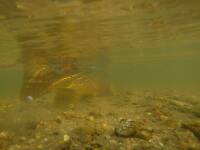
Blue-winged Olives
Baetis
Tiny Baetis mayflies are perhaps the most commonly encountered and imitated by anglers on all American trout streams due to their great abundance, widespread distribution, and trout-friendly emergence habits.
Featured on the forum

This is an interesting one. Following the keys in Merritt R.W., Cummins, K.W., and Berg, M.B. (2019) and Jacobus et al. (2014), it keys clearly to Ephemerella. Jacobus et al provide a key to species, but some of the characteristics are tricky to interpret without illustrations. If I didn't make any mistakes, this one keys to Ephemerella mucronata, which has not previously been reported any closer to here than Montana and Alberta. The main character seems to fit well: "Abdominal terga with prominent, paired, subparallel, spiculate ridges." Several illustrations or descriptions of this holarctic species from the US and Europe seem to match, including the body length, tarsal claws and denticles, labial palp, and gill shapes. These sources include including Richard Allen's original description of this species in North America under the now-defunct name E. moffatae in Allen RK (1977) and the figures in this description of the species in Italy.

Troutnut is a project started in 2003 by salmonid ecologist Jason "Troutnut" Neuswanger to help anglers and
fly tyers unabashedly embrace the entomological side of the sport. Learn more about Troutnut or
support the project for an enhanced experience here.
BxRxTxK on Jul 29, 2007July 29th, 2007, 4:44 am EDT
so I hooked into my first 20 plus inch brown the day before yesterday...I can only estimate the size by the couple of glimpses that I caught but I would say it would go 22...
I have been fishing this river for years and have never in my life seen a trout this big..
the river is fairly small, no more than 30 to 50 feet across in the wide sections, the fish bit a stonefly nymph dead drifted under a huge boulder
and it felt at first like I was hung on a big branch or something, but as it started to fight I realized that this was a monster fish, and then the panic of what to do with it set in...
I did my novice best attempt at playing it but, having never hooked a fish this big I wasn't really sure what to do and, after about a minute and a half it made a run and I couldn't give it line fast enough, and my 5x 5 lb tippet snapped...
I solemnly collected myself and went home...
that the tippet snapped instead of one of my knots was I guess the silver lining of the story but it seems little compensation when considering that this(the biggest trout ever to be on my line.)will haunt me for who knows how long...
being that alot of the rivers here are tight with no real space to let a fish take a long run, I was wondering if anyone had any tips on playing trophy sized fish in tight spaces?
thanks...
--------------------------->Buddy
I have been fishing this river for years and have never in my life seen a trout this big..
the river is fairly small, no more than 30 to 50 feet across in the wide sections, the fish bit a stonefly nymph dead drifted under a huge boulder
and it felt at first like I was hung on a big branch or something, but as it started to fight I realized that this was a monster fish, and then the panic of what to do with it set in...
I did my novice best attempt at playing it but, having never hooked a fish this big I wasn't really sure what to do and, after about a minute and a half it made a run and I couldn't give it line fast enough, and my 5x 5 lb tippet snapped...
I solemnly collected myself and went home...
that the tippet snapped instead of one of my knots was I guess the silver lining of the story but it seems little compensation when considering that this(the biggest trout ever to be on my line.)will haunt me for who knows how long...
being that alot of the rivers here are tight with no real space to let a fish take a long run, I was wondering if anyone had any tips on playing trophy sized fish in tight spaces?
thanks...
--------------------------->Buddy
Martinlf on Jul 29, 2007July 29th, 2007, 5:31 am EDT
Buddy, I recently landed a 19-20 inch fish in a small stream, and it was a guide's words coming back to me that probably allowed me to do it. First, I'll stress that you have to know when to give line and when to hold firm. I'm by no means a pro at this, but when a fish this big takes off you have to be able to relax some pressure on the tippet. The thing that helped me most with this fish, though, was to follow him and keep him on a short line. This helped me guide him and the line away from some snags and obstructions that could have ended our connection quickly. Also, when you don't need to pull a fish's head up that's trying to burrow to China, get your rod horizontal and use side pressure as much as possible, changing the angle from side to side to tire the fish and disorient him. But don't wear him down any more than absolutely necessary, and be sure he is fully revived and swims off in good shape. This is much easier in cold water, and I don't fish if the water is approaching 70 degrees F. Finally, hang that rabbit's foot around your rod wrist. I believe, more and more, that with some fish luck makes the difference. I'm not saying that skill doesn't give an angler a great advantage, but I believe some fish just aren't destined to be landed, and that if Lefty Kreh or Renee Harrop were playing them they'd still get off. Anyway, that's my story and I'm sticking to it. Good luck and tight lines,
"He spread them a yard and a half. 'And every one that got away is this big.'"
--Fred Chappell
--Fred Chappell
JOHNW on Jul 29, 2007July 29th, 2007, 5:59 am EDT
Buddy,
Not being critical but was it necessary to be using 5x for rolling stoneflies?
That being said consider the advantages you now have:
1 You know where this fish resides and can come back after him.
2 You know how she reacts to being hooked and can better anticipate.
Also see the thread on fighting big fish. Lot's of good info there.
JW
Not being critical but was it necessary to be using 5x for rolling stoneflies?
That being said consider the advantages you now have:
1 You know where this fish resides and can come back after him.
2 You know how she reacts to being hooked and can better anticipate.
Also see the thread on fighting big fish. Lot's of good info there.
JW
"old habits are hard to kill once you have gray in your beard" -Old Red Barn
BxRxTxK on Jul 29, 2007July 29th, 2007, 7:09 am EDT
thanks for the input guys...
I'm fishing a 3 wt rod so I like to go with a light setup all around, but maybe when I go back to this spot I will use a heavier tippet, now that I know the potential size fish that I am facing...
I never really believed the story's I had heard about people catching 27 inch fish out of this river until now, normally it's a good place to go if you want to catch alot of small to medium fish, and in an afternoon you can take 20 to 30 with little effort but none of them are ever huge..
but maybe this hookup was a sign that I should change my tactics because I normally end up fishing a.m. or midday.
this fish bit at almost 6:00 p.m. a time when I am rarely still out...
I may have to start hitting the dusk time frame and hope there are more late day feeding big browns in there...
Chris_3g
Posts: 59
Posts: 59
Chris_3g on Jul 31, 2007July 31st, 2007, 3:31 am EDT
Buddy,
I can empathize. I recently hooked what looked to be a 17-18 inch brown that I worked for about an hour - I'm stubborn, and this would have been my largest fish to date. Unlike every other brown in that stream, he refused to spook and continued to feed, so I just couldn't give up. Finally, he sipped a #14 Adams as if he didn't have a care in the world, and after about 10-15 seconds of working him toward the shore, he threw the hook. Needless to say, I was pretty disappointed.
With regard to larger than average browns in reasonably small streams, I've been reading a lot on night fishing lately, and while I haven't had any luck with it, I'll post some of the things that I've read - I'm inserting a disclaimer right now that I am NOT an expert, but I read a lot about this stuff to try to prepare for trips and whatnot. I would appreciate it if anyone who knows more from experience or otherwise would add to and / or correct me.
Large browns tend to forage feed at night. Especially with smaller streams, large browns have a hard time supporting themselves by drift feeding on small insects all day, so they need to go out and hunt for larger prey, e.g. bait fish, leeches, mice, crayfish, etc. A lot of these critters are more active in the evenings, so therefore, these browns are forced to feed accordingly. From what I understand, peak feeding times are oriented around midnight and just before sunrise, and the darker the better, i.e. the less moonlight, the better. I'm assuming that any time there is prey, however, the trout will be more active.
As far as fishing for large browns, I've read that you should fish big, black flies close to the surface, so that a nice silhouette forms against the night sky - Lloyd Gonzales' book has a nice bait fish imitation that fits the bill very well. I can see this advice as valid, but in my opinion, there's no reason why a woolly bugger (or the appropriate crayfish pattern) fished near the bottom wouldn't work as well. Regardless, I'm guessing that color isn't as important though. Basically, "loud" flies like woolly buggers or hackled wet flies are a good bet. I've also read that a lot of the darker-toned wet flies tied in larger sizes will also work, e.g. #6 Royal Coachman. The stonefly nymph you drifted would likely fall in the category of a possible night-time fly.
The other bit of info. that I found interesting was that these browns tend to move from the deeper holes, where they reside during the day, to shallower water at night. In fact, I've heard that at times, they move to water shallow enough to where their dorsal fins stick out of the water. I can actually testify to this, as on a recent outing, I spooked a nice sized brown out of shallow water when I know that earlier in the day, he had been residing in a deeper pool not far from there. Shortly after this spooking, I was nosing around and noticed a number of crayfish and bait fish hanging around that I hadn't seen earlier in the day, either.
I'm not saying the only way to catch large browns in small streams is to fish at night, but it's information that I found interesting, nonetheless! Like you, I had been doing a lot of my fishing in the AM or afternoon, but rarely in the evenings. After reading what I have, I have adjusted my fishing times to include evenings every so often. Hope this is useful, and again, if anyone wants to add to and / or subtract from what I've written, I would be more than happy to read what is written! Thanks a lot.
Chris.
I can empathize. I recently hooked what looked to be a 17-18 inch brown that I worked for about an hour - I'm stubborn, and this would have been my largest fish to date. Unlike every other brown in that stream, he refused to spook and continued to feed, so I just couldn't give up. Finally, he sipped a #14 Adams as if he didn't have a care in the world, and after about 10-15 seconds of working him toward the shore, he threw the hook. Needless to say, I was pretty disappointed.
With regard to larger than average browns in reasonably small streams, I've been reading a lot on night fishing lately, and while I haven't had any luck with it, I'll post some of the things that I've read - I'm inserting a disclaimer right now that I am NOT an expert, but I read a lot about this stuff to try to prepare for trips and whatnot. I would appreciate it if anyone who knows more from experience or otherwise would add to and / or correct me.
Large browns tend to forage feed at night. Especially with smaller streams, large browns have a hard time supporting themselves by drift feeding on small insects all day, so they need to go out and hunt for larger prey, e.g. bait fish, leeches, mice, crayfish, etc. A lot of these critters are more active in the evenings, so therefore, these browns are forced to feed accordingly. From what I understand, peak feeding times are oriented around midnight and just before sunrise, and the darker the better, i.e. the less moonlight, the better. I'm assuming that any time there is prey, however, the trout will be more active.
As far as fishing for large browns, I've read that you should fish big, black flies close to the surface, so that a nice silhouette forms against the night sky - Lloyd Gonzales' book has a nice bait fish imitation that fits the bill very well. I can see this advice as valid, but in my opinion, there's no reason why a woolly bugger (or the appropriate crayfish pattern) fished near the bottom wouldn't work as well. Regardless, I'm guessing that color isn't as important though. Basically, "loud" flies like woolly buggers or hackled wet flies are a good bet. I've also read that a lot of the darker-toned wet flies tied in larger sizes will also work, e.g. #6 Royal Coachman. The stonefly nymph you drifted would likely fall in the category of a possible night-time fly.
The other bit of info. that I found interesting was that these browns tend to move from the deeper holes, where they reside during the day, to shallower water at night. In fact, I've heard that at times, they move to water shallow enough to where their dorsal fins stick out of the water. I can actually testify to this, as on a recent outing, I spooked a nice sized brown out of shallow water when I know that earlier in the day, he had been residing in a deeper pool not far from there. Shortly after this spooking, I was nosing around and noticed a number of crayfish and bait fish hanging around that I hadn't seen earlier in the day, either.
I'm not saying the only way to catch large browns in small streams is to fish at night, but it's information that I found interesting, nonetheless! Like you, I had been doing a lot of my fishing in the AM or afternoon, but rarely in the evenings. After reading what I have, I have adjusted my fishing times to include evenings every so often. Hope this is useful, and again, if anyone wants to add to and / or subtract from what I've written, I would be more than happy to read what is written! Thanks a lot.
Chris.
BxRxTxK on Jul 31, 2007July 31st, 2007, 4:09 am EDT
thanks chris...
I like where you're line of thinking is going...
ever since I made this post I have been tying up some big, dark,
nymph variations...I may have to tie some big dark drys to go along with them...having had alot of experience fishing this river and never catching anything very big, I have to believe that the large nocturnal feeders theory rings especially true...
I have absolutely no experience fly fishing at night, so any info you could post in here or link me to would be well appreciated...
the day I hooked that fish I noticed the spinners of some type of mayfly depositing eggs on the riffles, the fly's were dark, bluish grey with greenish stripes and tails, and pretty big.(size 12 or 14.)
I was surprised that I didn't see any fish rise at all...
this seems to be the case most of the time around here, and that is why I end up nymphing which is usually fairly productive however less action packed...
hopefully I will make it out this evening to try for him again if the rain holds off...
thanks again...
-----------------------------Buddy
I like where you're line of thinking is going...
ever since I made this post I have been tying up some big, dark,
nymph variations...I may have to tie some big dark drys to go along with them...having had alot of experience fishing this river and never catching anything very big, I have to believe that the large nocturnal feeders theory rings especially true...
I have absolutely no experience fly fishing at night, so any info you could post in here or link me to would be well appreciated...
the day I hooked that fish I noticed the spinners of some type of mayfly depositing eggs on the riffles, the fly's were dark, bluish grey with greenish stripes and tails, and pretty big.(size 12 or 14.)
I was surprised that I didn't see any fish rise at all...
this seems to be the case most of the time around here, and that is why I end up nymphing which is usually fairly productive however less action packed...
hopefully I will make it out this evening to try for him again if the rain holds off...
thanks again...
-----------------------------Buddy
RleeP on Jul 31, 2007July 31st, 2007, 5:41 am EDT
Hi Buddy...
I'll sign on to most of what everybody else said and in particular wanted to endorse this from Louis:
>>I'm not saying that skill doesn't give an angler a great advantage, but I believe some fish just aren't destined to be landed>
I tend to believe that there are a certain number of fish out there whose role is to be the "Mystery Fish" and to be seen, briefly hooked but never brought to hand. Knowing they are always out there on the edge of the possible keeps the anticipation level high and helps us roll out to go fishing when the alarm goes off at 4AM.
You're fish may or may not be one of them. But that's what so great about this sport. You get to try a little heavier tippet and some other changes and find out for yourself.
I lived down there for a few years and fished the streams in the Pisgah NF pretty intensely. There are more difficult places to land a brown that size than the boulder-studded streams of the southern Appalachians, but not many. I had a number of 14" fish handcuff me the same way.
Good Luck!
lee
I'll sign on to most of what everybody else said and in particular wanted to endorse this from Louis:
>>I'm not saying that skill doesn't give an angler a great advantage, but I believe some fish just aren't destined to be landed>
I tend to believe that there are a certain number of fish out there whose role is to be the "Mystery Fish" and to be seen, briefly hooked but never brought to hand. Knowing they are always out there on the edge of the possible keeps the anticipation level high and helps us roll out to go fishing when the alarm goes off at 4AM.
You're fish may or may not be one of them. But that's what so great about this sport. You get to try a little heavier tippet and some other changes and find out for yourself.
I lived down there for a few years and fished the streams in the Pisgah NF pretty intensely. There are more difficult places to land a brown that size than the boulder-studded streams of the southern Appalachians, but not many. I had a number of 14" fish handcuff me the same way.
Good Luck!
lee
Martinlf on Jul 31, 2007July 31st, 2007, 7:12 am EDT
OK, I wasn't going to mention this, but Lee's words and Ed Engle's (quotation coming) compel me to. In Tying Small Flies Ed says, "The truth is that I usually lose fish through the normal comedy of angling errors such as poor line management, badly timed strikes, or overexcitement . . .." Since it always encourages me to have anglers I respect admit that fish sometimes get the better of them, I'll admit that I probably lost a fish yesterday by not following my own advice above. After playing this fish, probably a 16-18 inch bow, for about three minutes in the pocket where I hooked him (having stopped one run upstream) I let him run again to try to get him on the reel and get the loose loops of line where they couldn't tangle. He may have been one of my "mystery fish" no matter what I would have done, but I believe had I kept him on a short line by either stopping the run or following him, I would have netted him. As it was he burrowed under an undercut bank and used the roots, I believe, to help work the fly out. Oddly, I wasn't as irked as usual by this, partly because I felt that I understood what I had done wrong and would learn from it. It's those big fish that get off and I don't know if I should have done something different or not that have really perplexed and frustrated me in the past. As for the bow, as Lee said, I'll be rolling out of bed at 4 am for him one day--with my rabbit's foot dangling from my wrist. Oh I have to note this too . . . having landed a 17 inch brown earlier in the day may also have taken a little of the sting out of the loss.
"He spread them a yard and a half. 'And every one that got away is this big.'"
--Fred Chappell
--Fred Chappell
JOHNW on Jul 31, 2007July 31st, 2007, 10:02 am EDT
OK so I'm going to show some of my fly fishing roots here regarding the "Night Game".
Check out Joe Humphries work. He does a pretty thorough job discussing the issue in Trout Tactics and then there is his "Night Game" video. I don't care what folks think about his affiliations with certain Private Clubs the man can flat out fish.
JW
I guess you can take the boy out of Central PA but you cant take the Central PA out of the boy.
Check out Joe Humphries work. He does a pretty thorough job discussing the issue in Trout Tactics and then there is his "Night Game" video. I don't care what folks think about his affiliations with certain Private Clubs the man can flat out fish.
JW
I guess you can take the boy out of Central PA but you cant take the Central PA out of the boy.
"old habits are hard to kill once you have gray in your beard" -Old Red Barn
Shawnny3 on Jul 31, 2007July 31st, 2007, 10:50 am EDT
Robert Johnson, legend has it, sold his soul to the Devil at the crossroads in exchange for his incredible talent with the guitar.
Joe already had incredible talent with the rod before he ever met the Devil. So what, I ask, did he get in return for his soul?
I can buy big farm fish at the supermarket for $6.99 a pound.
-Shawn
Joe already had incredible talent with the rod before he ever met the Devil. So what, I ask, did he get in return for his soul?
I can buy big farm fish at the supermarket for $6.99 a pound.
-Shawn
Jewelry-Quality Artistic Salmon Flies, by Shawn Davis
www.davisflydesigns.com
www.davisflydesigns.com
RleeP on Jul 31, 2007July 31st, 2007, 1:44 pm EDT
From my dozen or so contacts with Joe over the years, I have to say that I like him. And it was always manifestly obvious to me that he felt very strongly the same way....:)
But yes, the man can flat out fish..
But yes, the man can flat out fish..
Grabbit on Aug 4, 2007August 4th, 2007, 4:33 pm EDT
Who is this Joe H.??? Seems all you guys in PA think he's the fishizzle??? Please the man started the same way I did... with a red and white bobber and box of worms. Chances are the man stopped fishing worms to keep his hands clean, or maybe he just figured worm fishing wasn't cool. If I hear one more PA guy say "I fished with Joe H. and he's the best" I will take it upon myself to type and puke at the same time. Joe H. is PA urban legend at best. The only worthy flea flicker the great state of PA has ever given birth to was a fella by the name of Vince M. everyone else falls under his shadow.
I am making a proclamation.... Grabbit is the best, Joe who? Joe what? Joe look at all them bugs bein gobbled up by them little trout like fish.
I am making a proclamation.... Grabbit is the best, Joe who? Joe what? Joe look at all them bugs bein gobbled up by them little trout like fish.
Fishing with nymphs is for fat little kids... man up and throw a dry.
Shawnny3 on Aug 5, 2007August 5th, 2007, 2:15 am EDT
I, for one, have never met Joe, so my opinions (as usual) are built mostly on ignorance. As for debating which flyfisherman is the greatest, it's a little like debating who the best musician is - it's more about publicity and opinion than it is about facts, so I'll refrain from making bold proclamations. We probably all know someone who, on a given day on a given stretch of water, could catch more fish than (insert name of famous flyfisherman here). Heck, I could probably throw on a good snagging rig and "outfish" Joe every day of the year, but I don't think anyone would call me the better fisherman for it. So quantity of fish is not a good measure (which is why I think flyfishing competitions are pretty silly), and any other measure is pretty subjective.
Personally, I prefer to measure fishermen based not on HOW MANY fish they catch but on HOW they catch fish, and that's a purely subjective measure applicable only as I watch them fish. A fisherman is great to me when he catches fish in places and in ways I've never seen anyone do before, and not because he took a class to learn how to do it. I like to see someone infuse their fishing with more creativity, analysis, and execution than I can muster. THAT is what impresses me, not size and number of Donny B. rainbows caught, or number of books published, or number of flies tied, etc. So you may hear me say something like, "So-and-so is the greatest fisherman I've ever seen," but you won't catch me saying, "So-and-so is the greatest fisherman ever."
I should also say that, in my opinion, no one can be considered a great flyfisherman unless he ties his own flies, and I mean his OWN flies. That is a great part (the larger part?) of the creativity, analysis, and execution I refer to above.
And Grabbit, I never thought I'd hear someone use the word 'fishizzle' on this forum. Thank you for putting the gangsta back in flyfishing. You got street cred, Homes.
-Shawn
Personally, I prefer to measure fishermen based not on HOW MANY fish they catch but on HOW they catch fish, and that's a purely subjective measure applicable only as I watch them fish. A fisherman is great to me when he catches fish in places and in ways I've never seen anyone do before, and not because he took a class to learn how to do it. I like to see someone infuse their fishing with more creativity, analysis, and execution than I can muster. THAT is what impresses me, not size and number of Donny B. rainbows caught, or number of books published, or number of flies tied, etc. So you may hear me say something like, "So-and-so is the greatest fisherman I've ever seen," but you won't catch me saying, "So-and-so is the greatest fisherman ever."
I should also say that, in my opinion, no one can be considered a great flyfisherman unless he ties his own flies, and I mean his OWN flies. That is a great part (the larger part?) of the creativity, analysis, and execution I refer to above.
And Grabbit, I never thought I'd hear someone use the word 'fishizzle' on this forum. Thank you for putting the gangsta back in flyfishing. You got street cred, Homes.
-Shawn
Jewelry-Quality Artistic Salmon Flies, by Shawn Davis
www.davisflydesigns.com
www.davisflydesigns.com
Grabbit on Aug 5, 2007August 5th, 2007, 7:13 am EDT
Shawn... I will except the cred. I just think it is flat out funny to travel out to Penns Valley and hear nearly every other fly rod toting fool tell me "hey I saw Joe back in 86... he was fishing that skinny water over at the Paradise... you know the one... and ole Joe was spanking two fish at a time while talking on a cellphone... and by the way he was using 9X"... while in PA one just can't get away from it. I swear it never fails. Its an inside joke with myself and a pal. I've come to expect the 'Joe-H-Namedrop' as it happens all the time. I'm curious to know if Joe realizes that he's the Paris Hilton of PA.
I agree with Shawn... tying your own flies is a must. I can not imagine doing it any other way. As you may know the grannoms got off to a late start on Penns this spring. I was on the river with nearly every form of grannom tied up, hell I think I had over 5 dozen or so perfect fly's at the ready and of course they never came off. Instead we caught the first emergence of subvaria at Poe Paddy. This event was a sight to see... the cold spring weather had put these bugs on hold way too long. By chance I had tied some last minute Henny's back in Columbus. I had wrapped an assortment of Henny emergers, duns, and cripples. I can tell you the wood stick and Peerless got a work out that afternoon. The emerger patterns I'd wrapped used quail and kid for the shuck. The wise ole Penn toads that fell to these emerger patterns were mind blowing, simply beautiful trout!!! The best part of it was we had the entire no kill section of Penns to ourselves. Between each sucking rise we spilled one Joe H. joke after another, puffing on Fuentes with a warming sun on our backs, and striking on the big wild trout. It was a perfect way to welcome spring back into Penns Valley. I can still hear the screams of the Peerless and the sight of cripples that blanketed every little back eddy in that special stretch of water. Dare I say... "Life is friggin good when you are w/out question the best." Dare I say!? Joe who?
.....Grabbit.....
I agree with Shawn... tying your own flies is a must. I can not imagine doing it any other way. As you may know the grannoms got off to a late start on Penns this spring. I was on the river with nearly every form of grannom tied up, hell I think I had over 5 dozen or so perfect fly's at the ready and of course they never came off. Instead we caught the first emergence of subvaria at Poe Paddy. This event was a sight to see... the cold spring weather had put these bugs on hold way too long. By chance I had tied some last minute Henny's back in Columbus. I had wrapped an assortment of Henny emergers, duns, and cripples. I can tell you the wood stick and Peerless got a work out that afternoon. The emerger patterns I'd wrapped used quail and kid for the shuck. The wise ole Penn toads that fell to these emerger patterns were mind blowing, simply beautiful trout!!! The best part of it was we had the entire no kill section of Penns to ourselves. Between each sucking rise we spilled one Joe H. joke after another, puffing on Fuentes with a warming sun on our backs, and striking on the big wild trout. It was a perfect way to welcome spring back into Penns Valley. I can still hear the screams of the Peerless and the sight of cripples that blanketed every little back eddy in that special stretch of water. Dare I say... "Life is friggin good when you are w/out question the best." Dare I say!? Joe who?
.....Grabbit.....
Fishing with nymphs is for fat little kids... man up and throw a dry.
Taxon on Aug 5, 2007August 5th, 2007, 10:13 am EDT
Grabbit-
Many of us who are drawn to this site are somewhat obsessed, but I must commend you for having one of the more interesting obsessions. Further, I must agree with what appears to be one of your pet peeves, as name dropping should be studiously avoided.
Many of us who are drawn to this site are somewhat obsessed, but I must commend you for having one of the more interesting obsessions. Further, I must agree with what appears to be one of your pet peeves, as name dropping should be studiously avoided.
JOHNW on Aug 5, 2007August 5th, 2007, 11:01 am EDT
Maybe I missed something and please feel free to set me straight.
The theme of night fishing came up along with a queery for info.
I suggested a work I'm very familiar with by an author who is fairly well known. No name dropping or stunning proclamations of being the best just an honest reccomendation.
The theme of night fishing came up along with a queery for info.
I suggested a work I'm very familiar with by an author who is fairly well known. No name dropping or stunning proclamations of being the best just an honest reccomendation.
"old habits are hard to kill once you have gray in your beard" -Old Red Barn
Shawnny3 on Aug 5, 2007August 5th, 2007, 11:35 am EDT
You're right, John. If anyone is guilty of having begun the commentary on Joe, it is I. My apologies. I probably should have just kept my mouth shut. Man, how many times do I say that?
And Grabbit, if you think the Joe H. hero worship is out of hand, you should hear how the Centre County crowd go on about that other Joe. I once overheard a 16-year-old female student of mine bragging to another girl that she had touched him. Nowhere else is a 90-year-old man treated like Justin Timberlake.
-Shawn
P.S. I just had to say that after seeing you're from Columbus, Grabbit. My wife is an Ohioan, and we root for the Bucks in spite of the locals.
And Grabbit, if you think the Joe H. hero worship is out of hand, you should hear how the Centre County crowd go on about that other Joe. I once overheard a 16-year-old female student of mine bragging to another girl that she had touched him. Nowhere else is a 90-year-old man treated like Justin Timberlake.
-Shawn
P.S. I just had to say that after seeing you're from Columbus, Grabbit. My wife is an Ohioan, and we root for the Bucks in spite of the locals.
Jewelry-Quality Artistic Salmon Flies, by Shawn Davis
www.davisflydesigns.com
www.davisflydesigns.com
Grabbit on Aug 5, 2007August 5th, 2007, 2:05 pm EDT
John and Shawn please except apology if I've in ANY way offended you. Being new to this site and not a lurker of untold years I have no clue as to anyone's tolerance levels for sarcasm. I have just found it alarmingly strange that grown men would ever treat anyone in our fortuitous sport like a rockstar. Surely all of the sane of this wonderful sport realizes that knowledge increases your odds for success and therefore increases your enjoyment. Having a strong knowledge base of aquatic bugs (trout chow) is perhaps the best weapon one can take to the river. No doubt Joe has a major weapon based in insect knowledge. Some guys can go to the river with an assortment of royal coachmen the rest of their lives and be quite satisfied by catching two or three stocker trout... I ask "hey why not they hatch every night around midnight but mostly they are a size twelve"... thats what I read on the Net but I still have many more fish take the size 28 Coachmen I tie. The only problem with tying those litle ones is finding the right size hackle. Maybe they should kill them roosters earlier for a better size 28 feather count? Baby roosters everywhere could blame me for it... I say so what as long as Joe H. does'nt take the credit I'll be a legendary baby rooster killer and that would without question send me straight to the path of greatness I deserve. Get a life and stay out of my backcast... that goes for you friggin trees too.
....Grabbit....
....Grabbit....
Fishing with nymphs is for fat little kids... man up and throw a dry.
IEatimago on Aug 6, 2007August 6th, 2007, 11:39 am EDT
this reminds me of graffiti.
Grabbit on Aug 6, 2007August 6th, 2007, 12:01 pm EDT
Maybe you dont believe the royal coachman hatches start at midnight? Go check it out... but stay till at least 3:00am if nothing happens. They come off like gangbusters in the month of August.
If I knew how to post pictures on this forum I would show you the evidence. I will try with photobucket. I think you'll like this graffiti....
If I knew how to post pictures on this forum I would show you the evidence. I will try with photobucket. I think you'll like this graffiti....
Fishing with nymphs is for fat little kids... man up and throw a dry.
Quick Reply
Related Discussions
Topic
Replies
Last Reply
0
Jan 21, 2017
by Mcflyangler
by Mcflyangler
2
Jan 23, 2017
by Mcflyangler
by Mcflyangler
3
Aug 31, 2013
by Jmd123
by Jmd123

